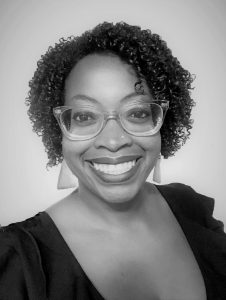
In her work, Ariana Curtis focuses on the idea of community — especially within black and Lantix narratives in the predominantly white field of museum studies.
Curtis, curator of Latinx studies at the Smithsonian National Museum of African American History and Culture, will speak at 10:45 a.m. Thursday, August 22 in the Amphitheater as part of Week Nine, “Exploring Race and Culture in America with Wynton Marsalis and Jazz at Lincoln Center.”
“I’m talking about what it means to create ‘we’ — the idea of community — speaking specifically about my own academic expertise, which is on this continuum of African American and Latinx identities,” Curtis said. “I’m talking about race and gender and how we represent those things in museum spaces.”
Curtis is a Fulbright scholar and anthropologist. She has worked in two museum spaces: her current role as curator in the NMAAHC, and her past role as curator of Latino Studies at the Smithsonian Anacostia Community Museum. Each museum centers African American culture, identity and history — making each an exceptional space in the museum field, Curtis said.
“I’ve always worked in black museums, so it wasn’t really until I had to contextualize the work in my TED Talk that I realized how exceptional my curatorial experiences have been,” Curtis said.
Curtis explained that in a 2018 study, the Andrew W. Mellon Foundation — and several other organizations — surveyed over 300 art museums regarding gender and racial demographics of their staff — and found some severe disparities.
“Eighty-seven percent of the museums’ collections were male, and 85% were white,” Curtis said. “Ninety-three percent of all museum directors were white, 92.6% of board chairs were white, and 89% of board members were white. In some of the higher-paid positions like curators, educators and museum leaders, 84% of those jobs were (held by) white people.”
In her 2018 TED Talk, Curtis spoke on the need for authentic representation of women in museums, focusing on more than just the most famous women in history.
“Representation matters,” Curtis said, opening her TED Talk. “Authentic representations of women matter. I think that too often, our public representations of women are enveloped in the language of the extraordinary.”
Curtis said the talk gave her an opportunity to dive into the diverse realm of narratives — which are often filtered through a predominantly white lens.
“It was an opportunity for me to showcase collections that center black women and non-white women, given how museums generally tell stories and who is generally telling the stories,” Curtis said.
For that talk — and for any public speaking event — Curtis said she had to consider the context of museums and of her own curatorial experiences.
“I’m going to end with talking about curating these stories for TED, for a digital audience that’s outside of museum spaces, and what it means to contextualize the complete lack of diversity in the museum field for someone who’s always worked in black museum spaces,” Curtis said.
Unlike curating an exhibition, Curtis said, public lectures are a highly visible form of education, one in which her own appearance and identity become part of the narrative.
“When I curate an exhibition, people don’t necessarily know what I look like or who I am — they’re just enjoying the information on the wall,” Curtis said. “But when you do a public talk like Chautauqua or TED, who you are as a person has everything to do with the message you’re delivering and how it’s received. I had to think hard about what I wanted to say about museums, what I wanted to say about my position in museums as an Afro-Latina, as a curator, knowing these statistics of the field.”
In Curtis’ experience, multidisciplinary cultural studies can surprise museum visitors.
“Because we don’t often study non-white populations against each other, sometimes people are interested — or confused, even — about what Latinx studies can look like in an African American space,” she said.
Curtis said she hopes to educate listeners on the multitude of experiences her field of study includes — more than just the “exceptional” experiences often highlighted.
“ ‘Black’ is a very diverse category,” Curtis said. “ ‘Women’ is a diverse category — that’s kind of the point of the ‘everyday’ narrative. It’s really about diversity and inclusion, that you have to change the narrative in order to be inclusive, rather than just adding one or two exceptional people on top of a narrative that never included them.”




